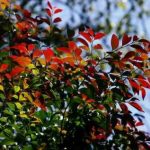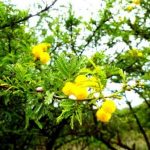TREE SOCIETY
APRIL 2001
SUBS ($200) ARE DUE ON 1ST APRIL. PLEASE USE THE INVOICE ATTACHED TO THIS TREE LIFE WHEN MAKING PAYMENT, INDICATING IF YOUR ADDRESS HAS CHANGED.
MASHONALAND CALENDAR
Tuesday 3 April Botanic Garden Walk meet in the car park of the Botanic Garden where we will meet Tom at 4.45 for 5pm.
Sunday 15 April This month’s outing is cancelled due to our trip to Chimanimani.
Saturday 28 April Mark’s Walk is in Meyrick Park.
Saturday 5 May. Botanic Garden Walk.
NB Walks are switched to Saturday morning due to the shorter afternoons during the winter months.
Sunday 20 May NOTICE OF ANNUAL GENERAL MEETING
Notice is hereby given that the 51st Annual General Meeting of the Tree Society of Zimbabwe will be held on Sunday 20th May, 2001 at the lecture theatre next to the tea room in the Botanic Gardens, Fifth Street.
AGENDA
- Notice convening the meeting.
- Apologies.
- Minutes of the 50th A.G.M.
- Matters Arising.
- Chairman’s Report.
- Treasurer’s Report.
- Election of Committee Members.
- Any Other Business.
Any proposals/resolutions and nominations for office bearers should be forwarded to P O Box 2128, Harare by Monday 14th May if possible, although proposals and nominations will be accepted from the floor.
MATABELELAND CALENDAR
N.B. Outings for the Matabeleland Branch have been re-scheduled to the second Sunday of each month.
Sunday 8 April. Please phone any of the Bulawayo Committee members for details
DROSERA, THE SUNDEWS … Continued.
As mentioned in the first part, Zimbabwe has but a few species and their distribution hasn’t been fully ascertained, basically because they have been relatively poorly collected. I wonder whether man-made changes to vleis, bogs & wetlands haven’t also affected their distribution’ I also mentioned that sundews have only once appeared in the pages of Tree Life. Since then the earliest editions I have -dating back to Tree Life No. 146 – have been dumped into the computer and I came across one more citation. In early 1994 the Matabeleland members found some plants in the eastern Matopos; “Alison pointed out the carnivorous sundews Drosera burkeana and Drosera indica growing in the water” (April 1994 No. 170). In fact, the Matopos was a fruitful collecting area; hilly country with undrained seeps and vleis probably provide the best sanctuary for these fragile plants, viz. Eastern Highlands, Domboshawa and similar isolated refrugia, long may they last. It is also interesting to mention that I once found a plant or two near Ruckomechi Camp on the edge of Mana Pools, many years ago. It must remain unnamed but on reflection was possibly Drosera burkeana (though a!titudinally this seems wrong) as it was a rosulate species, growing on the edge of a seasonal ‘oxbow’ of the Zambezi. But that is the only record for the Zambezi Valley – now where did it come from?’
Drosera indica.
This is an annual herb, caulescent with a stem of 3-50 cm which appears to like wet-feet and can be partly submerged. The leaves are alternate (1-10 x 0.05-0.3 cm), linear and glandular with petioles 0.1-1.5 cm long, glandular-pubescent. Peduncles (scapes) emerge laterally from the leaf axils and are 0.5-15 cm long, elongating to their greatest length during flowering. The inflorescence is 3-20-flowered on pedicels 0.3-2 cm long and the petals are usually pink, but ranging from rose-red to purple. Being an annual it hasn’t been found on the Highveld after June, usually a little earlier, but this must depend on the seasonal rainfall or on ‘wetter cycles’. Eyles, ‘Salisbury’, collected the June record in 1920 (with dramatic changes to the city’s wetlands since then does it occur anymore?). However, there are later records from the Eastern Districts where conditions are wetter and it is perhaps perennial there? Most collections are from the Eastern Districts (Nyanga to Chimanimani), across to Rusape and Mrewa, Harare (Domboshawa, Cleveland), Chibi (near Lundi River bridge) and Matopos. The single record from Sengwa Research Institute shows we should be looking in other parts of the country! With its linear leaves it is quite different to our other Drosera, being annual it must reproduce from the many seeds dropped the year before.
Drosera burkeana.
This widespread perennial herb has leaves forming a basal rosette. The lamina (2-10 x 2-9 mm) is suborbicular and the petiole, up to 2 cm long, is narrow throughout its length then broadens abruptly into the lamina. It has 1-4 scapes, 4-30 cm Song, arising laterally from the rosette then curving to become erect, and the whole plant is a glorious deep crimson red in full sun. The inflorescence is racemose, often secund, 2-12-flowered on pedicels 0.2-1.2 cm long. The petals are white or pink. This species has been found over the high veldt from Mvurwi to Harare (Domboshawa, Chinamora), Marondera, and Headlands/ Rusape to the Vumba & Nyanga Road; with only 1 record each from the latter E. District localities it may not be too common at higher altitudes? However, only fuller collecting will delineate its limits. The two records further south are from the Sebakwe River and Bikita, and I add Buchwa mentioned in part one – I’m sure it would have been this species.
Drosera, dielslana.
This perennial herb is similar to burkeana but the petiole broadens gradually into the obovate-spathulate lamina (0.3-1.5 x 0.2-0.7 cm., the petiole being 0.3-3.5 cm long. The 1-2 (but up to 6) scapes are 2-17 cm long, like burkeana arising laterally from the rosette then curving to become erect. The inflorescence is also racemose, 3-12-flowered on pedicels 1-5 mm long. The petals are pink or crimson to reddish-purple (note prior comment re apomixis). So here grows a possibly confusable species apart from the fact that dielsiana is an upland species found in Nyanga and Chimanimani, often on steep faces near waterfalls. Drosera, affinis. This perennial herb, caulescent like the next, presents some difficulty and can be easily confused with madagascariensis. A specimen from Zambia in the National Herbarium is a particularly strong looking plant with a thick stem, otherwise the stem is thinner, 1-23 cm long, bearing alternate leaves which are clustered towards the apex. The leaves are mostly erect, but occasionally on the lower parts of the stem descending; lamina (0.3-3 x 0.2-0.5 cm) narrowly oblanceolate or narrowly oblanceolate-oblong, glandular around the margin of the upper surface, glabrous or sparsely pilose below. The stipules are 0.3-1.3 cm long, apex lacerated, thus being generally longer than madagascariensis. The petioles are 0.5-7 cm long, very slender, glabrous or very sparsely pilose. It has 1-4 scapes, 8-45 cm long, arising laterally from the stem, and then curving to become erect, glabrous.
To digress for a moment, the Herbarium specimen mentioned above had a 45 cm scape that branched. The Flora of Southern Africa describes the genus as having cymose inflorescences while Flora Zambesiaca Vol. 4 calls them racemose or cymose. I personally find our species to be racemous but this one plant could be an example of a cyme! The inflorescence is racemose, 3-13-flowered on pedicels 2-10 mm long, glabrous or sparsely pilose. The petals are the same as madagascariensis but generally white or purple. In Zimbabwe this species has only been collected from two areas, Beatrice and Nyanga. The chief differences used in keys are: Leaves borne on the stem, clustered towards the apex; lamina narrowly obovate; seeds fusiform:
affinis
Petiole 2-5 times the length of the lamina, very slender, glabrous or very sparsely pilose on both surfaces, erect in age.
madagascariensis
Petiole 1-2(3) times the length of the lamina, slender, usually pilose on the under surface, reflexed in age.
Drosera madagascariensis
Perennial herb, caulescent, but occasionally apparently acaulescent by reduction; stem up to 25 cm long. The leaves are alternate, clustered and erect at the top of the stem, but deflexed lower down whereas affinis tends to be more erect. The lamina (0.5-1.5 x 0.2-0.5 cm) elliptic, obovate or spathulate, glandular, especially towards the margins above, sparsely pilose below; stipules up to 5 x 1 mm, oblong, lacerated at the apex. The petioles 1-3 x 0.03-0.1 cm, glabrous or pilose above, usually pilose (rarely glabrous) below. The 1-2 scapes are 9-55 cm long, arising laterally below the top of the stem, then curving to become erect, glabrous, glandular or pilose. The inflorescence is 2-14-flowered on pedicels 1-10 mm long, glandular or pilose. Petals are pink or purple with one specimen described as red.
Localities are from the 3rd gorge of the Zambezi, Victoria Falls (Zambia), Gokwe District (Sengwa Research & further east), Harare (in 1919!), Marondera, the Eastern Highlands (Nyanga, Chimanimani & Banti). Further southwards it has been collected from the Victoria District and Matopo Hills. Recent sites (July 2000) at Domboshawa and north Chiweshe Just go to show how the glittering, sticky ambit of our sundews remains fertile terra incognita.
Ian Riddell
IN PRAISE OR OTHERWISE OF THE JACARANDA TREE LIFE NO. 252 FEBRUARY 2001
I read John Wilson’s article on Jacarandas with interest and thought readers of Tree Life may be interested in a beekeeper’s views on Jacarandas. As far as beekeepers are concerned, Jacarandas are very desirable trees indeed as they are the source of considerable quantities of a very pale, distinctive honey. Many of Zimbabwe’s indigenous trees produce dark, strongly flavoured honey and, by comparison, I personally find Jacaranda honey rather insipid but, as lighter coloured honey is more popular with many customers, honey with a Jacaranda content is a highly marketable product.
Interestingly, the Jacaranda is not an important bee tree in some parts of the world, including its native Brazil. The Brazilian beekeepers’ handbook Manual de Apicultura edited by Joao M. F. Camorga, makes no mention of it in its fairly extensive list of both indigenous and introduced bee plants, although several otherBignoniaceae family plants are listed.
Similarly, in the South African Department of Agricultural Technical Services book Beekeeping in South Africano mention is made of Jacaranda. Beekeepers that I know operating in and around “Jacaranda city”, otherwise known as Pretoria, tell me that it is of little significance to them.
Herr Reinhard Fichtl in his book Honeybee Flora of Ethiopia states that good nectar production is reported from the northern parts of Ethiopia but, in other areas, no nectar is produced. When I met Herr Fichtl a few years ago, he expressed surprise that in Zimbabwe the Jacaranda is such an important bee tree.
As with many plants, the dynamics of nectar secretion by Jacaranda is very poorly understood.
-Peter Taylor Banket.
JACK BARNES’ CEDARS
When the body of Ieyasu was laid to rest on the Nikko Hills, his successor in the Shogunate called upon the Daimyos of the empire to each send a stone or a bronze lantern to decorate the grounds about the mortuary temples. All complied but one man who was too poor to send a lantern but offered to plant trees along the road that future visitors to the tomb might be protected from the heat of the sun. His offer was accepted and has proved one of the most magnificent of all monuments. The avenue has been kept intact, trees blown or cut down being replaced. This famous avenue was formed at the beginning of the seventeenth century.
DALLIMORE & JACKSON –HANDBOOK OF CONIFERAE AND GINKGOACEAE
From 1911 to 1922 the Rhodes Inyanga Estate was managed by JW (Jack) Barnes, a horticulturist, who was responsible for establishing most of the plantations we see in the Nyanga National Park today. Barnes lived in a stone house that was used until recent times by successive managers of the apple orchards at the Government Experiment Station. The old house is just across the road from the orchards, and only a few hundred metres from the offices and sheds of the experiment station.
In the grounds of the house are two large Japanese cedars, Cryptomeria japonica (Taxodiaceae). They were planted during the period of Barnes’s occupancy of the house, and in April 1987 one of them was 30 metres tall, with a diameter of 93.6 cm. The other was taller, at 32 metres, but its diameter could not be measured because the trunk was thickly covered by ivy, Hedera helix. These two trees are as tall as the best in the beautiful avenue of Japanese cedar at Stapleford Forest, near Penhalonga, but they have rather bigger diameters, which probably makes them the largest specimens of their kind in Zimbabwe.
Japanese cedar is not a true cedar, a name that belongs to the genus Cedrus (Pinaceae), but the common English name is derived from the cedar-like fragrance of its wood. The Japanese call the tree sugi, and sometimes by such colourful names as “peacock pine” and “goddess of mercy fir”. It is widely propagated in its native land – often by cuttings – and makes up about one third of the total area of Japanese forests. Many famous avenues in Japan were planted to this species, some of them now more than 650 years old, with trees 40-55 metres tall. The wood is reddish, fairly soft, but strong, durable, easy to work, and sometimes handsomely figured. In Japan it is used for all types of construction, joinery, panelling, furniture, etc. In Zimbabwe it is very site selective, and does not thrive in granite-derived soils.
-Lyn Mullin
In Retrospect (Continued) By Lyn Mullin
MATHEMATICAL PLANTS
A ROOTNOTE from Kim Damstra in TREE LIFE No.51 (May 1984):
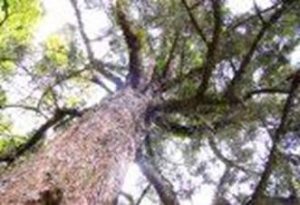
Podocarpus latifolius. Photo: Bart Wursten. Source: Flora of Zimbabwe
For those interested in mathematics, plants provide some interesting facts in terms of phyllotaxis, or leaf arrangement. Take any branch that shows a spiral leaf arrangement, and trace a line from any given leaf to that leaf vertically above it, following the natural spiral of the branch. Count the number of times the spiral goes around the stem, and how many leaves are passed on the way (including one of the end leaves in the number). For example, in the yellowwood, Podocarpus latifolius, the spiral goes around the stem three times, and it is the eighth leaf that is directly above [the start-point leaf]. This can be expressed as the fraction 3/8. If a number of different plants are examined it will be discovered that only a limited number of these fractions exist in nature. They form an interesting series 2/5, 3/8, 5/13, 8/21… This series, in which each numerator (or denominator) is the sum of the two preceding numerators (or denominators), is known as a Fibonacci series. If these fractions are expressed as decimals they tend towards a limit of 0.38197. In practical terms this value can be translated into a fraction of a circle, 360 degrees, such that 0.38197 x 360 = 137 degrees 30 minutes 28 seconds. This is known as the ideal angle because, if the angle between two successive leaves is set at this, no two leaves would be directly above each other. A different set of Fibonacci numbers occurs in the cones of cycads and pines. If these are examined two sets of spirals will be seen – one set going clockwise around the cone, and the other anti-clockwise. One set of spirals is always steeper than the other, and also has more rows. If the number of spirals running one way and the other is expressed as a fraction, a new series of numbers emerges: 2/3, 3/5, 5/8, 8/13, 13/21… Most of the Encephalartos cones at the University have a 5/8 arrangement, although an 8/13 cone is also present. This series tends towards 0.61803. These fractions have been known for many years, and have fascinated successive generations because the two numbers have a distinct relationship: 0.38197 + 0.61803 = 1, and the ratio 0.38197 : 0.61803 = the ratio 0.61803 : 1. This latter ratio demonstrates the solution to an interesting mathematical problem: “to divide a line into two parts such that the relationship between the smaller and the greater is the same as the relationship between the larger part and the whole line”.
MORE ON MATHEMATICAL PLANTS
In TREE LIFE No.55 (August 1984) Kim Damstra contributed another ROOTNOTE on phyllotaxis:
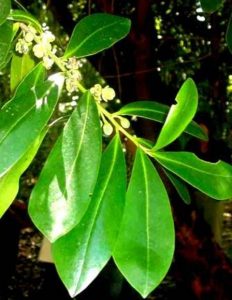
Warburgi salutaris; Photo:Bart Wursten. Source: Flora of Zimbabwe
It is strange how leaf arrangements always get split into opposite or alternate (or whorled), when, in fact, a lot of what is called alternate is really a spiral of leaves up the branch. If you remember all that stuff about Fibonacci, all of these spirals can be defined by the phyllotaxis: take a leaf, find the one directly above it, trace the spiral around until you come to this leaf, count the number of times you went round the stem, and put that over the number of leaves in that set (include only one of the end leaves in that set, as the other one would belong to the adjacent set). All of these numbers should fall in the Fibonacci series: 1; 1; 2; 3; 5; 8; 13; 21… where each number is the sum of the two preceding numbers. An opposite arrangement would be 1/2. If you visualize an upright twig at noon, when the sun is directly overhead, each leaf will directly shade the second leaf below it. A rose usually has a 1/3 arrangement – this is more ideal as each leaf shades the third leaf below it. As one progresses along the series to 3/8, which is a common arrangement found in the bay-leaf tree, avocado, and yellowwood, each leaf shades the eighth leaf below it. So, as one progresses in the series, the better the arrangement becomes to prevent mutual shading. Of course, in nature branches are seldom upright, and the sun is not [vertically above]. In addition, the light is not always direct, but rather it becomes diffuse and is scattered. So the practical benefit of such an arrangement may not be all that significant. But it is an added point to be aware of; some families do have alternate leaves – the Annonaceae, for example – whereas others have a spiral – Warburgia salutaris the Canellaceae.
I mention this because the Canellaceae – represented here by Warburgia salutaris, the cure-all for all complaints, which may no longer exist in the wild due to its famous medicinal qualities – has now been removed from its position alongside the violet family, Violaceae, and is thought to fit more naturally with the magnolias alongside the Annonaceae (Conquist 1981). I cannot question this move, but it is interesting to look at the vegetative features of these families. Although the books refer to them both as [having] alternate [leaves], Warburgia has a spiral arrangement (I noted a 2/5 phyllotaxis in the Botanic Garden). This is not an obvious feature of the Annonaceae, but it is interesting how often spirals turn up around the primitive magnolias. The bay-leaf and avocado, along with Ocotea and Cryptocarya are all in the Lauraceae, a closely related family. I have not yet checked to see how consistent the spiral arrangement is within a species – could it possibly be used in a key?
WOOD ANATOMY A ROOTNOTE from Kim Damstra in TREE LIFE No.56 (October 1984):
Wood anatomy is an interesting subject which I don’t know a vast amount on, but the general idea is conifers have soft wood, whereas dicotyledons have hard wood. The reason for this is that conifers rely entirely on small cells called tracheids for the movement of water from the roots to the leaves. Flowering plants have tracheids, but they possess xylem vessels as well. The vessels are wider cells, open at both ends, which connect in a vertical series to form continuous tubes up the stem. With this effective transport system, other cells within the dicot trunk form specialized strengthening cells and fibres. As a result, the wood is often stronger and denser, and is known as hardwood. In contrast, the softwood of conifers, with mainly tracheids, has a homogeneous structure, which is easily workable and is also suitable for paper making.
A few very primitive dicot trees may have simple wood without vessels, as well as their simple flower structure. If tracheids are less efficient conductors than vessels, and cannot deliver the same rate of flow, what difference does this make to the distribution of conifers, as opposed to dicot trees? One reference I found explained that, in general, the conifers overcome their poor transport system by controlling their evaporative water loss, or transpiration. As a result, they tend to be xerophytic, with specialized leaves, and are generally more successful in marginal environments. Here the tracheids are less of a disadvantage. Thus, in nature, conifers dominate the boreal forest, and grow on the dry mountains of Nyanga (Widdringtonia and Juniperus). This was all very well, but how do the yellowwoods (Podocarpus) fit into this explanation? One suggestion [was that] possibly in the abundance of water, such as in the high-rainfall forests, this difference in wood anatomy is less important as trees compete for nutrients and light. Here, the yellowwoods thrive well. One wonders whether the poor wood anatomy is responsible for the preferential demise of the conifers in and around Harare in the past year. If anyone has any further comments on this topic, they would be most welcome.
[Comment 2000: While it is true that conifers generally have soft wood, and are known in the timber trade as softwoods, a number of conifers have harder wood than many dicots. In South Africa, for example, Pinus canariensis is grown for telephone and powerline transmission poles only, because the wood is too hard and heavy for normal building construction. It is too hard to nail! One of New Zealand’s conifers, Prumnopitys ferruginea (formerly Podocarpus ferrugineus), has wood that is harder and heavier than our Zambezi teak (Baikiaea plurijuga). At the other end of the scale, the wood of balsa (Ochroma lagopus), a dicot, is the lightest and softest of all commercial timbers.The 1983-84 drought certainly took out a lot of conifers, especially cypresses, but I do not believe it was simply a drought effect. The cypress aphid, Cinara cupressi, was particularly active during that drought, and killed off most of the highly susceptible trees. This aphid, incidentally, is most active during the dry-season, and usually inactive during the rains. All members of the Cupressaceae, including our own Widdringtonia nodiflora, have been affected by the aphid, but individual trees within species have shown great resistance, or even complete immunity. Conifers generally have spreading root systems, not deep ones, and immediately prior to the 1983-84 drought we had had a long and exceptionally wet weather cycle, which had raised the water table and “drowned” a large proportion of the finer roots of the coniferous trees. The suddenness and severity of the drought cycle of the early 1980s caught these trees high and dry, and, with the depredations of the cypress aphid thrown in as well, many of the cypresses had no chance. Another factor in this whole equation is the extensive area of vlei land within greater Harare, and the presence of pines and cypresses on sites that are subject to waterlogging and total drying out. In their natural habitats they would not normally be found in what we call vleis, but in our wisdom – or lack of it – we have planted them “off-site”, and problems can always be expected.
Finally, while it is true that the conifers tend to dominate the boreal forests, pines in particular have been pushing steadily southwards, and about half the 110 or so species of Pinus are found in tropical and subtropical regions. They are prevented by the Sahara Desert from extending any further into Africa than the southern coastline of the Mediterranean Sea, and by the central American rainforest from spreading southwards from Nicaragua. Only one species, Pinus merkusii, has succeeded in crossing south of the equator – in the island of Sumatra in Indonesia – but several species are within 12-13 degrees of the equator in central America and southeast Asia.]
In Retrospect will be continued
MFUTI FLUSHING IN MID-MARCH
Those who joined Mark’s botanical walk at Charmwood on 24 February will remember that practically all the Brachystegia boehmii (mfuti) on the property were badly affected by what appeared to be a sort of rust on the foliage. Every leaflet was covered by the rust, and the trees did not look at all good. But when I visited the property on 19 March I found that just about every specimen of mfuti was flushing, and the rust-covered leaflets were beginning to drop off. New leaves that had already turned green seemed to be entirely free of the rust.
Well-out-of-season flushing of Brachystegia is unusual enough to set one looking for a reason, and it would seem that the mfuti at Charmwood had been under sufficient stress to force a very late flush of new leaves in an attempt to shake off the rust. Anyone with any other ideas?
-Lyn Mullin
THE LUPANE UMTSHIBI
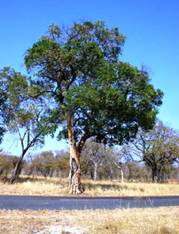
Guibourtia coleosperma. Photo: Bart Wursten. Source: Flora of Zimbabwe
Not many large umtshibi trees managed to escape the woodcutter’s axe during the heyday of timber exploitation in the dry, deciduous forests of Zimbabwe’s Kalahari sands. so we don’t know today just how big these trees could become. Umtshibi, Guibourtia coleosperma, is one of the three major commercial components of the Kalahari-sand forests of northwestern Matabeleland, and along with Zambezi teak, Baikiaea plurijuga, has supplied most of the wooden railway sleepers and parquet flooring produced in Zimbabwe over more than 80 years.
The largest umtshibi known in Zimbabwe today stands at Kilometre 70 on the road from Bulawayo to Victoria Falls. The second largest, and a finer-looking tree than the first, stands exactly halfway along the 5-kilometre stretch of tarred road linking Lupane administrative centre with the main highway to Victoria Falls. It is on the south side of the link road, and just off the tar. In June 1987 it was 22 metres tall, with a diameter at breast height of 1.19 metres, a crown spread of 21 metres, and an unbranched bole length of about 4 metres. The wood of this species is of the same weight and colour as that of Zambezi teak, but it lacks the black flecks and streaks that are characteristic of the latter. Umtshibi seeds can be roasted and ground into an edible meal, and the oily red arils have been a famine food in times past.
-Lyn Mullin
ANDY MACNAUGHT CHAIRMAN


